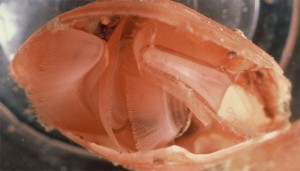
Source: DOC. Brachiopod, Paterson Inlet
If you are the type of nature lover who prefers beautifully strange beings to normal species, a visit to Ulva Island-TeWharawhara should satisfy your cravings. When you dive beneath the waves of the ocean, it almost seems as though some of the fish are walking. As you begin to explore further, you see creatures that look unearthly. Keen photographers, budding marine conservationists, and those who are simply curious will all enjoy a visit to this Marine Reserve.
Strange Yet Beautiful Marine Reserve Life
Ulva Island-TeWharawhara was once an ancient valley. Over the course of thousands of years, water has slowly crept up to engulf it. Now humans no longer stand there; fish do instead. One species in particular almost seems as though it is walking. Owing to their odd structure, the blue cod at this Marine Reserve may sometimes seem as though they are walking towards you rather than swimming.
The sea life even gets stranger than that. Between 300 and 550 million years ago, brachiopods dominated this area. Today, you can find plenty of brachiopod fossils, but hardly any of the spectacular creatures in their living form. If you enjoy seeking out rare finds, looking for a brachiopod may prove to be one of your greatest challenges.
If seaweed stirs your interests, you can look forward to seeing 31 green, 56 brown, and 174 red species. That’s more than any other area in New Zealand. Even if seaweed is a highlight for you, don’t take any away. It’s against Department of Conservation (DoC) rules.
Water Activities at Ulva Island-TeWharawhara
You can swim at Ulva Island-TeWharawhara, but take a wetsuit. Peak water temperatures hit 12 degrees Celsius in February and drop to 8 degrees in July. If you want to snorkel, take a waterproof flashlight to probe between the kelp and expose yourself to more sea life. Again, resist the temptation to disturb the local ecosystem. You cannot fish.
The waters in this area are pristine and calm, making them ideal for boaters and kayakers. If you approach calmly, you can see sea lions, seals, and yellow-eyed penguins. The waters around this area are calm enough to take children kayaking, just make the most of wetsuits to prevent colds.
Enjoying a Comfortable Stay
It is possible to enjoy a comfortable stay without disrupting the local wildlife. First, you cannot camp at Ulva Island-TeWharawhara. However, you can make the most of nearby island life at Stewart Island. If you don’t like the idea of going solo or leading your own trip, join one of the guided tours that take place throughout the year. Many of these leave from Stewart Island, giving you a stress-free chance to explore Ulva Island-TeWharawhara.
If you want to spend a day at Ulva Island-TeWharawhara, take a picnic and plenty of fluids. However, you cannot start fires there and littering is prohibited. Under the Marine Reserves Act 1971, polluting the water is against the law.
Although the seas at the island are calm, you do need to bear in mind that the water temperatures change rapidly. The DoC recommends wearing a wetsuit and full hood to dive, for your own health.
Visiting Ulva Island-TeWharawhara allows you to see some of New Zealand’s rarer marine species. As a Marine Reserve that is suitable for many, it is a great option for anybody traveling in a group with varying ages and abilities.
